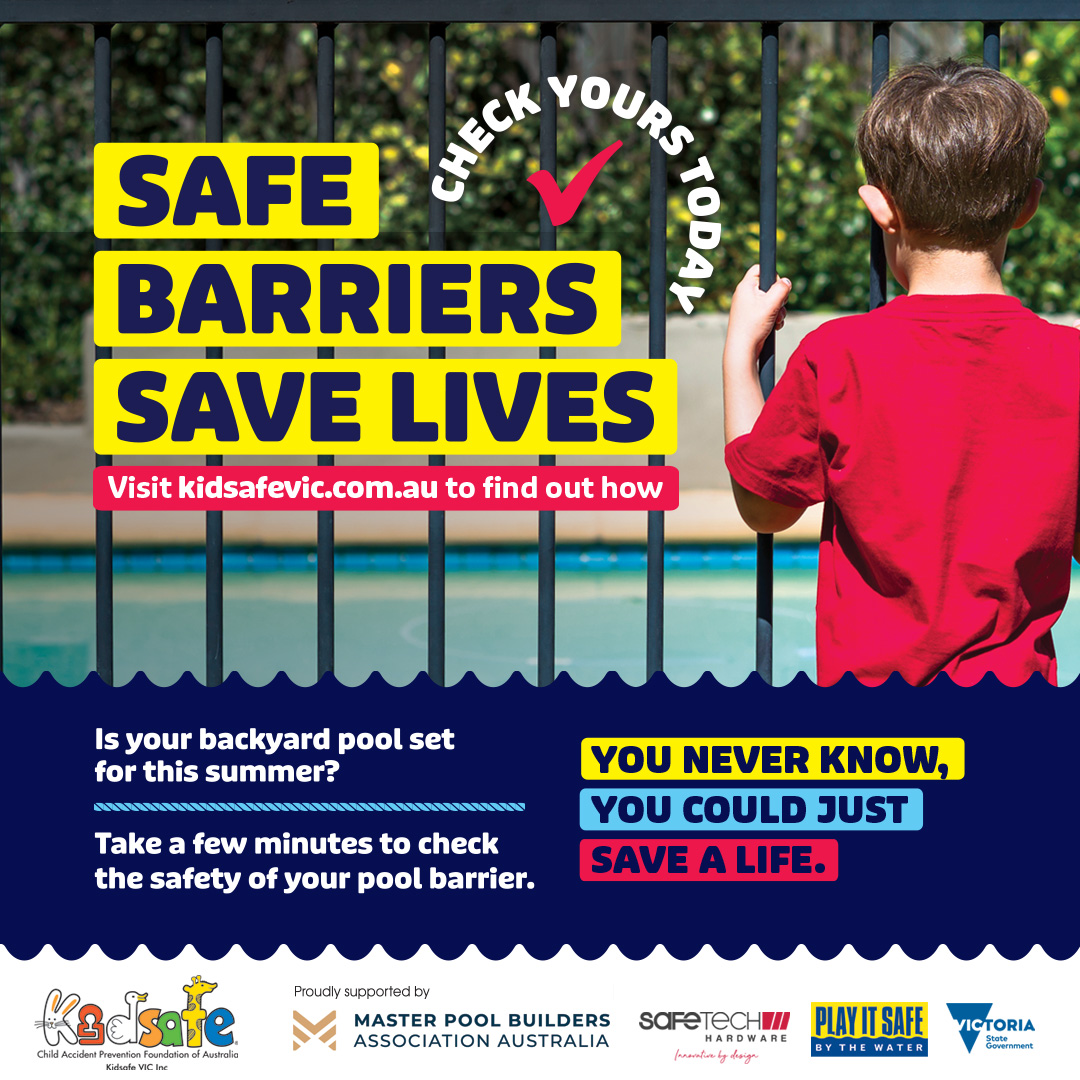Olympic Swimming Champion Matt Welsh, OAM, partners with Kidsafe to help save kids’ lives

With Victorian families looking forward to the resumption of pool parties and social gatherings this summer, Kidsafe today launched their annual ‘Safe Barriers Save Lives’ campaign, calling on homeowners to ‘help save a life’ by checking their pool and spa barriers at the beginning of daylight saving.
The launch comes as concerning figures released in the Royal Life Saving Society of Australia’s National Drowning Report show that in 2020/21, 25 Australian children aged 0-4 years drowned – a 108% increase on the previous year and the largest number since 2016/17.
Swimming pools were one of the most common locations where these incidents occurred (8), accounting for 32% of all toddler drownings.
Jason Chambers, General Manager of Kidsafe Victoria, highlighted that toddlers were particularly at risk as they are attracted to water but don’t yet understand the dangers it can pose.
“Children can drown quickly and silently – a split second is all it takes for them to gain unsupervised access to the water area and find themselves in trouble.”
Mel Anderson knows just how quickly this can happen, as she almost lost her 10-month-old son while at a Christmas family barbeque.
“One second Matt was playing on the ground at my feet and the next, as there was no pool fence to prevent him crawling over to the pool, he fell silently into the water. I felt sick – I thought he was gone.”
“Thankfully, my Dad had just completed a first aid course the week before and started performing CPR straight away. I’m told it was the difference between life and death for my son. I am so grateful that he is still here with me but the after effects of that day still traumatise me”, said Ms Anderson.
While pool and spa barriers are effective in helping to reduce childhood drowning incidents, Mr Chambers explained that a large number of drowning deaths are the result of barriers that are faulty, have not been maintained, or are non-compliant with Australian standards.
Campaign ambassador and Australian Olympic swimming champion, Matt Welsh OAM, knows the benefits that learning to swim and growing up around water can provide for children. As a father of six, he also acknowledges the risks that swimming pools and spas can pose if strategies aren’t put in place to help keep children safe.
“It’s important to check that barriers and gates are in good working order as we head into the warmer months – particularly as many of us will be spending more time in and around the backyard pool this summer. By doing so, you could save a child’s life.”
Top 5 Issues with pool and spa barriers
Kidsafe has highlighted the top 5 faults or non-compliance issues which are important for all homeowners to regularly check and maintain. These include:
- ● Gate or door is no longer self-closing
- ● Gate or door is no longer self-latching
- ● Gate is propped open for convenience – allowing children unsupervised access
- ● Gaps, holes or spaces in and under the barrier which a child can get through
- ● Climbable objects near the pool barrier e.g. BBQ’s, outdoor furniture, eskies, trees etc.
Chris Samartzis, CEO of the Master Pool Builders Association Australia, highlighted the importance of pool and spa owners conducting regular checks of their barriers.
“Pools and spas provide endless hours of fun for families. Maintenance and compliance of pool and spa barriers is vital because they are exposed to the extremes of weather all year round which can lead to rust, loose or missing bolts or screws and wear and tear over time.”
Along with a compliant pool or spa barrier that is regularly checked and maintained, Mr Chambers said it is also important for parents and carers to take a number of other actions to help keep their children safe around backyard pools, including:
- ● Active adult supervision – for toddlers, this means having an adult within arm’s reach at all times when in or around water.
- ● Water awareness – Water awareness and learn to swim classes can assist in helping children to become familiar with water, teaching them about water safety and learning how to swim
- ● CPR/First Aid knowledge – Kidsafe encourages all parents and carers to enrol in a CPR/First Aid course and to update their skills regularly. Doing so will assist in ensuring they are equipped to respond if an emergency does arise
For more information, please visit Kidsafe Victoria’s pool and spa safety website
We would like to say a big thank you to our generous sponsors who helped make this campaign possible, the Victorian Play it Safe by the Water committee, Safetech Hardware Australia, and Master Pool Builders Association of Australia (MPBAA).
Background on near drowning incident with Mel and Matthew
In 2007 during the Christmas holiday season, Mel Anderson was enjoying a family barbeque in regional Victoria sitting with her husband and Dad when within seconds her 10-month-old son, Matthew, disappeared from where he was playing at her feet.
He had crawled outside and as there was no pool fence to prevent him gaining access to the pool, he fell silently into the water.
There were other family members there all watching out for young Matthew, yet he disappeared so quickly and quietly.
All the family got up and searched for him, then her husband found him in the pool and dragged him out. Thankfully, Mel’s Dad had just completed a First Aid course the week before and started performing CPR straight away.
As her Dad – Matthew’s Granddad – worked to breathe life back into her little son and got his heart beating, Mel recalls that it felt like hours passed and she felt sick with the thought that her son was gone. When the paramedics arrived, they took over CPR but there was still no response. Then the air ambulance arrived and he was airlifted by helicopter to the hospital.
He was put into an induced coma, and Mel was told by the Doctors that there was no hope for her son – he would likely die or at the very least suffer brain damage.
Miraculously, after 4 days, Matthew woke up and showed no signs of any brain injury. Doctors believe it was the fast actions of Mel’s Dad performing CPR that was the difference between life and death for her son.
Today, 14 years later, Matthew is a happy, strong boy living a full life – he is very fortunate not to have any ongoing issues. As for Mel – she lives with Post Traumatic Stress Disorder (PTSD) and suffers anxiety every day about Matthew being out of her sight.

